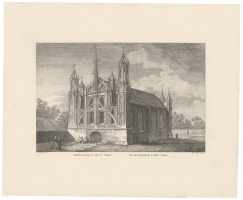
The Church of St Anne in Vilnius
| Author: |
Zygmunt Vogel (1764–1826) |
| Created: | 1807 |
| Material: | paper |
| Technique: | etching |
| Dimensions: | 47 × 62.50 cm |
| Signature: | below image left: Frań. Smugliewicz ryssował below image right: Zygmunt Vogel sztychował 1807 inscription: WIDOK KOŚĆIOŁAS: ANNY W WILNIE. / VUE DE L’EGLISE DE S: ANNE A VILNA |
Etching after Franciszek Smuglewicz.
In the late 18th century, Joachim Chreptowicz, the chancellor of the Grand Duchy of Lithuania and honorary mayor of Vilnius, ordered a series of drawings of the city from Franciszek Smugliewicz (1745–1807). Unfortunately, the drawings have disappeared. However, an engraving made from one of them, showing St Anne’s Church, has survived. It was made in 1807 by Zygmunt Vogel (1764–1826), an artist from Warsaw. Due to its pronounced vertical forms, the Gothic style was out of fashion in the late 18th and early 19th century. Therefore, in keeping with the ideals of Classicism, the Gothic proportions of the church were ‘corrected’ and ‘beautified’ in order to satisfy Classical taste. The Church of St Anne was lowered and widened, turning the graceful Gothic building into a massive and stocky structure. Its importance was emphasised by removing it from its surroundings beside the Bernardine Church, and placing it in complete isolation in a natural setting.
Text author Laima Laučkaitė
The views of Vilnius that Franciszek Smuglewicz drew in the late 18th and early 19th centuries, and his most famous images of architecture, were a major force in the development of the genre in Lithuania. Not all the originals of his works have survived to our days. He produced numerous drawings of the Church of St Anne and the Bernardine friary. The Church of St Anne in the engraving by the Warsaw artist Zygmunt Vogel (1764–1826) appears to be isolated from its architectural context: the enclosed church seems to stand in the countryside. This may have been to express the opinion that St Anne’s predated the Bernardine friary, and was founded by Anna, the wife of Vytautas the Great, and built at the end of the 14th century. During the 1794 uprising, a fire started by the Russian army badly damaged the church, charring its brick walls and causing the bricks to split. The architect Michał Szulc, who restored the church in 1800–1801, attempted to reinforce the façade by bricking up two side entrances and covering the base of the walls with white plaster. Smuglewicz depicted the restored church.
According to the inscriptions on some of the prints, the engraving by Vogel was dedicated to the Lithuanian patriot Aleksander Pociej (1774–1846), a participant in the uprising under Tadeusz Kościuszko, a former aide-de-camp of Jokūbas Jasinskis, and great quartermaster of the Grand Duchy of Lithuania. It is possible that he financed the early 19th-century restoration of the church.
Text author Rūta Janonienė
Source: Law firm Valiunas Ellex art album VILNIUS. TOPOPHILIA I (2014). Compiler and author Laima Laučkaitė, RES PUBLICA (2018). Compiler and author Rūta JanonienėExpositions: “Vilnius. Topophilia. Views of Vilnius from the collection of the law firm Ellex Valiunas”, 5 October – 26 November 2017, National Gallery of Art, Vilnius (curator Laima Laučkaitė) "Vilnius Time", 5 June 2023 – 1 May 2024, Lithuanian Art Centre TARTLE (Užupio St. 40, Vilnius). Curators Ieva Burbaitė and Emilija Vanagaitė.







